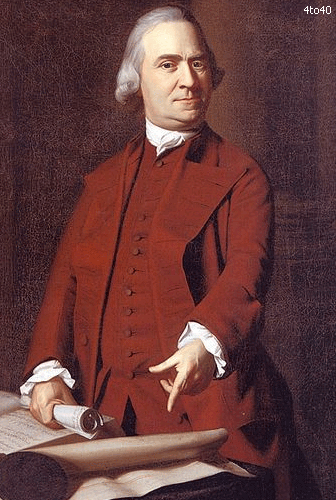 Samuel Adams was born on September 27, 1722 in Boston, Massachusetts. He was one of twelve children born to Samuel and Mary Fifield Adams. However, only two of his siblings would survive beyond age three. He was a second cousin to John Adams, the second president of the United States. Samuel Adams’ father was involved in local politics, even serving as a representative to the provincial assembly.
Samuel Adams was born on September 27, 1722 in Boston, Massachusetts. He was one of twelve children born to Samuel and Mary Fifield Adams. However, only two of his siblings would survive beyond age three. He was a second cousin to John Adams, the second president of the United States. Samuel Adams’ father was involved in local politics, even serving as a representative to the provincial assembly.
Education
Adams attended Boston Latin School and then entered Harvard College at the age of 14. He would receive his bachelor’s and master’s degrees from Harvard in 1740 and 1743 respectively. Adams tried numerous businesses including one he started on his own. However, he was never successful as a commercial businessman. He took over his father’s business enterprise when his father died in 1748. At the same time, he also turned to the career that he would enjoy for the rest of his life: politics.
Samuel Adams’ Personal Life
Adams married in 1749 to Elizabeth Checkley. Together they had six children. However, only two of them, Samuel and Hannah, would live to adulthood. Elizabeth died in 1757 soon after giving birth to a stillborn son. Adams then married Elizabeth Wells in 1764.
Early Political Career
In 1756, Samuel Adams became of Boston’s tax collectors, a position he would keep for almost twelve years. He was not the most diligent in his career as a tax collector, however. Instead, he found that he had an aptitude for writing. Through his writing and involvement, he rose as a leader in Boston’s politics. He became involved in numerous informal political organizations that had a large control over town meetings and local politics.
Beginning of Samuel Adams’ Agitation Against the British
After the French and Indian War that ended in 1763, Great Britain turned to increased taxes to pay for the costs that they had incurred for fighting in and defending the American colonies. Three tax measures that Adams opposed were the Sugar Act of 1764, the Stamp Act of 1765, and the Townshend Duties of 1767. He believed that as the British government increased its taxes and duties, it was reducing the individual liberties of the colonists. This would lead to even greater tyranny.
Samuel Adams’ Revolutionary Activity
Adams held two key political positions that helped him in his fight against the British. He was the clerk of both the Boston town meeting and the Massachusetts House of Representatives. Through these positions he was able to draft petitions, resolutions, and letters in protest. He argued that since the colonists were not represented in Parliament, they being taxed without their consent. Thus the rallying cry, “No taxation without representation.”
Adams argued that colonists should boycott English imports and supported public demonstrations. However, he did not support the use of violence against the British as means of protest and supported the fair trial of the soldiers involved in the Boston Massacre.
In 1772, Adams was a founder of a committee of correspondence meant to unite Massachusetts towns against the British. He then helped expand this system to other colonies.
In 1773, Adams was influential in fighting the Tea Act. This Act was not a tax and, in fact, would have resulted in lower prices on tea. The Act was meant to aid the East India Company by allowing it to bypass the English import tax and sell through merchants it selected. However, Adams felt that this was just a ploy to get colonists to accept the Townshend duties that were still in place. On December 16, 1773, Adams spoke at a town meeting against the Act. That evening, dozens of men dressed as Native Americans, boarded three tea ships that sat in Boston Harbor and threw the tea overboard.
In response to the Boston Tea Party, the British increased their restrictions on the colonists. Parliament passed the “Intolerable Acts” that not only closed the port of Boston but also limited town meetings to one per year. Adams saw this as further evidence that the British would continue to limit the colonists’ liberty.
In September, 1774, Samuel Adams became one of the delegates at the First Continental Congress held in Philadelphia. He helped draft the Declaration of Rights. In April, 1775, Adams, along with John Hancock, was a target of the British army advancing on Lexington. They escaped, however, when Paul Revere famously warned them.
Beginning in May, 1775, Adams was a delegate to the Second Continental Congress. He helped write the Massachusetts state constitution. He was part of the Massachusetts ratifying convention for the US Constitution.
After the Revolution, Adams served as a Massachusetts state senator, lieutenant governor, and then governor. He died on October 2, 1803 in Boston.
 Kids Portal For Parents India Kids Network
Kids Portal For Parents India Kids Network






